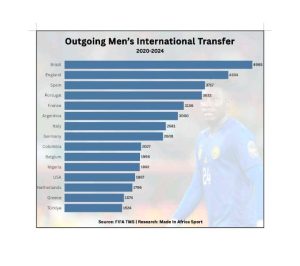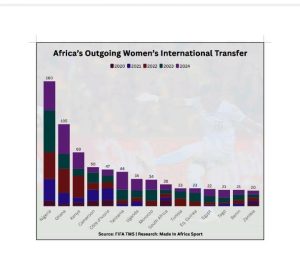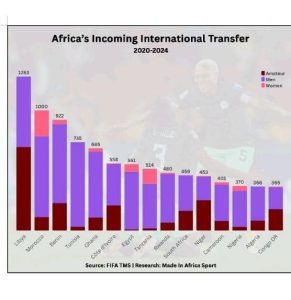Footballers from Africa have always been in demand across the world. From Europe to Asia and the Americas, players from the continent have left home in search of bigger opportunities, stronger competitions, and better wages.
For most of them, the dream is clear: to play at the highest level, in the biggest leagues, and under the brightest lights. But for every player who makes it to Europe’s elite clubs, thousands more leave the continent in search of opportunities, navigating a system where talent alone is never enough.
Over the last five years, this movement has only intensified. Some are well-established professionals, transferring for millions of dollars, while the majority are amateurs hoping to break into the professional scene in obscure leagues rather than wait for opportunities at home. Then there are the women footballers, a growing but still underrepresented group whose international moves signal progress and the long road ahead for gender equity in football.
The data behind this migration is sourced from FIFA’s Transfer Matching System (TMS), extracted through the Global Transfer Report on 28 February 2025. It includes all international transfers of football players completed between 1 January 2020 and 31 December 2024.
At the forefront of this talent exodus is Nigeria, the undisputed leader in football exports. With 3,915 outgoing transfers since 2020, the country has supplied more footballers to foreign leagues than any other African nation. Among them, 1,992 are professional male players, a number that places Nigeria just behind Belgium in the global rankings of football exporters.

Nigeria is also leading the way in women’s football exports, with 160 female players moving to foreign leagues directly. This is more than any other African country, proving that Nigeria is the country where women’s footballer seeks greener pastures more than elsewhere on the continent.
Ghana follows closely, exporting 2,064 players since 2020. The country has long been known for producing highly technical and disciplined footballers, with scores of them finding success in leagues across Europe and beyond. Of these transfers, 1,190 were male professional players, while 769 amateur footballers left the country in search of better opportunities.
Women’s footballers are also leaving Ghana rapidly, with a continent-high 38 players transferring out internationally in 2024 for a total of 105 players over the last five years. This puts Ghana just behind Nigeria and ahead of all other 42 African nations to have sold at least a single player in that period.

The African Nations bringing in the most foreign footballers
While it is good that African players are being recognized and recruited by foreign leagues, there is also the issue of how to strengthen African domestic competitions so that fewer players feel the need to leave. Even though the real question is whether they can retain their top talents rather than just serving as a stepping stone to Europe and Asia, the level of internal transfers within Africa itself and also small-scale importations from abroad suggests that the continent’s leagues are growing.
Football is a sport of movement, not just on the pitch, but also across borders. While much is said about African players leaving the continent for foreign leagues, there is also a growing trend of players moving into Africa.
Over the last five years, some African countries have increased their intake of foreign players, attracting talent from around the world. Whether for financial reasons, league development, or strategic recruitment, these countries are now becoming major importers of footballers, shifting the narrative of African football as purely an exporter of talent.

Libya took the top spot as the biggest importer of footballers in Africa, with a total of 1,283 international transfers recorded. While the country has faced challenges on all fronts in recent years, football remains an important part of its identity. The majority of these transfers have been amateur players, with 695 moving into Libya, while 588 professional male footballers have also joined Libyan clubs. Women’s football, however, has yet to see any international transfers, palpably due to the absence of a women’s league in the country.
Morocco has also been a major destination for foreign players, bringing in 1,000 international transfers. Unlike Libya, Morocco’s recruitment has been more balanced, with a strong presence in women’s football as well. Out of the total imports, 673 were professional male players, while 216 female footballers also joined Moroccan clubs. This makes Morocco the topmost African country actively attracting foreign women’s talent, showing their commitment to the growth of women’s football. Amateur transfers have been fewer, with only 111 players moving in at that level.
Benin is another country that has seen a surge in foreign player recruitment, bringing in 922 transfers, of which 299 are amateurs. The country has mostly targeted professional male players, with 657 moving to Beninese clubs. Women’s football, which has not seen much growth, had 36 female players arriving from abroad.
Interestingly, Benin has been raiding their bordering neighbor, Nigeria, to poach players. Of all the 242 international transfers the country had in 2024, 120 were Nigerians, representing 50% of their entire imports.
427 total views, 2 views today



